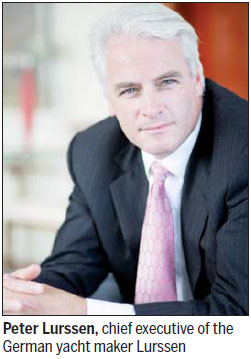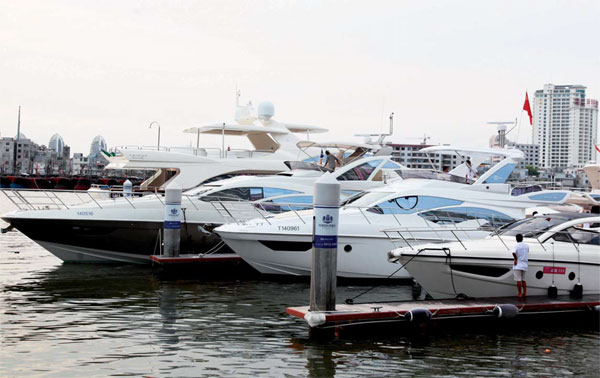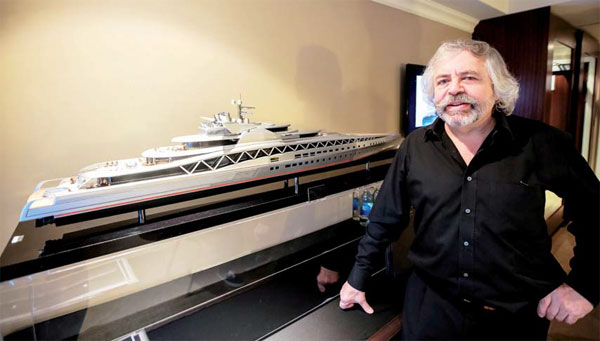The lure of floating opulence
Updated: 2014-02-14 08:50
By Cecily Liu (China Daily Europe)
|
|||||||||||
|
Yachts on show at the fourth annual Hainan Rendez-Vous in Sanya in April. China has become a new focus for Western yacht makers. Provided to China Daily |
Rich Chinese are dipping into the world of luxury yachts
China has become a new focus for Western luxury yacht makers as the global downturn has hit Western buyers hard and emerging markets such as Russia and the Middle East are still maturing.
Karaoke bars and mahjong tables are increasingly becoming common on luxury yachts, whose makers were once content to install sunbathing decks and fine-dining tables to meet customer demand.
The yachts, priced at as much as a few hundred million dollars, are widely seen as the ultimate status symbol, after sprawling mansions, expensive cars and private jets.
The market is relatively new for China, and Western brands are keen to seize the first-mover advantage as the market grows.
"The Chinese market is extremely important," says Mohammed Al-Barwani, chairman of the Dutch yacht maker Oceanco.
"It is a fast growing market, and it is getting more and more sophisticated."
Oceanco has attended the annual Chinese yacht exhibition, Hainan Rendez-Vous, for the past four years, Al-Barwani says.
"The idea is to invest today for a market that will develop in the next four to five years."
Some Chinese have expressed an interest in Oceanco's yachts and have visited the company's manufacturing site in the Netherlands, he says. Oceanco says it has built yachts for Chinese owners living outside China but not for customers in the country.
Al-Barwani's optimism about the Chinese market is shared by Burak Akgul, managing director of sales, marketing and design at Perini Navi, an Italian manufacturer.
Perini Navi set up a sales office in Hainan last year, managed by Enrico Zanella, an Italian who has lived in China since 1999 and who has become established in the country's yachting industry.
"For us, finding the right person to work with was important," Akgul says. "Enrico has worked hard with some contacts that he already had."
Companies like Oceanco and Perini Navi are still finding their feet in China, but the potential is immense. Figures cited by the yacht charter company YPI Asia in 2011 showed that there are about 1,300 private yachts in China.
This compares with 17 million privately owned recreational boats in the US, the world's biggest yacht market, industry publication International Boating Industry says.
Chinese companies that recognize the potential have started buying Western yacht companies or set up joint ventures. Last year the Chinese conglomerate Dalian Wanda Group bought Sunseeker International for 320 million pounds ($525 million; 388 million euros).
In 2012, the construction and agriculture machinery giant Shandong Heavy Industry Group bought a controlling stake in the Italian luxury yachtmaker Ferretti SpA in a deal worth $500 million.
Despite the potential size of the Chinese yacht market, the country still lacks marine infrastructure to support the industry, including marinas that host yachts, experienced yacht crews and luxury harbors that sailors could enjoy.
The most popular marinas in China are in Qingdao, Shanghai, Hong Kong and Hainan, but sailing between them would take at least one to two days each.
Those distances are a deterrent to sailors, so Chinese people are not exposed to the idea of being able to see many places within a short cruising time, says Peter Lurssen, chief executive of the German yacht maker Lurssen.
"It's not the concept in the Mediterranean when you go with your boat to Nice, and cruise casually over to Cannes for half an hour, and you go swimming. In the evening you go to San Tropez, which takes another two hours, and the next day you go shopping in Monaco, which takes three hours."
Were it not for the fact that China lacks marinas, and that it is difficult for foreign owners to obtain cruising permits, more Chinese would have embraced sailing, he says.
Under Chinese regulations the skippers of foreign yachts must report to authorities everywhere they berth, and some yacht owners regard that as too much hassle, Lurssen says.
Few yachts sail to China, and if more did, Chinese people would see for themselves that doing so is not that complicated, he says.
Hainan has seven marinas with a total of 1,170 berths, and the province's yacht industry development plan calls for 25 more marinas with 14,200 berths, to be built by 2030.
Al-Barwani acknowledges that the lack of marinas is a problem. Those in the yacht-building and related sectors would benefit from such investment, he says.
"Typically, hotels, yacht clubs and resort companies find more business opportunities if the yachting industry grows."
In addition, Al-Barwani says, China needs time to build support sectors such as yacht maintenance, insurance, and banking and finance.
Another big barrier for Western yacht exporters is an import tax of about 40 percent on yachts sold to China, he says.
One way of overcoming this problem would be to set up joint production of yachts in China, he says, adding that he thinks current demand for yachts in the country is insufficient to make such activity sustainable for Oceanco, which makes mainly big yachts.
Lurssen calls the high yacht tax prohibitive and says it is "a way to keep foreign-built yachts out". The secondary yacht market, which further facilitates the affordability of yachts in the West, is almost non-existent in China because Chinese customers are barred from importing a vessel that is more than a year old, Lurssen says.
As Chinese are exposed to yachting for the first time, many buyers find it difficult to decide exactly what features they want on their yachts, a problem many Western bespoke yacht builders have to contend with.
Lurssen says: "The concept of a bespoke yacht, meaning someone comes and explains the concept of a yacht he wants, and getting exactly that but having to wait for four or five years for his yacht to be built, is not appealing to Chinese."
It may be the idea of owning a yacht that appeals to Chinese, so those who make smaller ready-made yachts are likely to find it easier to sell their vessels.
The yachts that Lurssen makes, which are up to 180 meters long, dwarf these vessels, so they must have a buyer before building begins.
Lurssen's difficulty in selling its wares without being able to display them in China is common to many yacht builders. Some focus on small vessels and may display finished yachts at boat shows in China, chancing their arm for sales, but others regard the financial risk as far too great.
Simply talking about yachts and displaying models at boat shows like Hainan Rendez-Vous is ineffective because plenty of other things are going on at the show to distract potential customers, Akgul says.
"Aircraft, helicopters, motorcycles anything and everything that could be given a luxury connotation is crammed in this area," he says of Hainan Rendez-Vous.
"We were not expecting to do deals, but we hoped to have some opportunity to get in touch with people we could at least (talk with). We didn't even do that. From a commercial perspective it was ineffective."
However, one luxury yacht maker built a yacht at his own expense, took it to Hainan Rendez-Vous and sold it, Akgul says. According to industry insiders, a builder who took a yacht to the Singapore Yacht Show last year managed to strike a deal with a Chinese customer too, he says.
Perini Navi will attend the Singapore Yacht Show in April because one of its customers will be in Singapore at the time and is happy for his yacht to be displayed at the show.
"If you have a boat to show, the likelihood is that you will sell something," Akgul says.
"That seems to be an interesting track record. So if we go in April, we might sell a boat."
The Dutch yacht maker Feadship managed to strike its first deal in China by showing a yacht at Hainan Rendez-Vous in 2012.
"Customers can go on the boat to see it, admire the quality and design, and understand a bit more what yachting is all about, the complexity and what it can bring you," says Feadship's director, Dick van Lent.

A Chinese customer liked the yacht so much that he ordered one from Feadship that was very similar to the yacht on display, van Lent says.
The customer took delivery of the yacht, Blue Sky, last year, and Feadship hosted the launch ceremony, which included Chinese lion dances.
Blue Sky is 44.65 meters long, has a dedicated karaoke area with an 85-inch television and a mahjong room with a table that shuffles the tiles and deals the dice automatically. The exterior has a helicopter deck.
"We have learnt that the Chinese do not like to be exposed to the sun, so we have most decks covered and some entertainment outdoors," van Lent says.
While karaoke and mahjong rooms are now commonly identified as popular Chinese features, designing for Chinese customers is not limited by such stereotypes.
Ken Freivokh, who heads his own yacht design company, Ken Freivokh Design, says Chinese customers always want the best in quality and design, even though they are still in the process of learning what this means.
"We are at an early stage of the Chinese getting involved with yachts. The first few years, maybe five or six years, they're there just to learn about them, before they start to do special things. It's not just one owner coming on his own to talk to the designers, it's usually an owner team."
Freivokh's team previously had a contract with the yacht maker Sunseeker International over 13 years, through which he served several Chinese buyers.
Unlike Russian customers, the Chinese are "quite relaxed about having a nice product" and emphasizing quality, he says.
Chinese customers often show their yachts to friends and recommend that they buy similar ones.
"What we find is that the next owner comes with the previous owner and takes advice from him."
Freivokh says he expects Chinese customers to contribute more interesting thoughts on yacht design as they become more mature buyers, and this will make his job more interesting.
"I think the Chinese have fewer preconceptions. When we are dealing with European or American customers, they have been surrounded by certain yachts. They come to us with a big baggage of assumptions, and we almost have to deliver the same as what they expect."
Such preconceptions in the West may have been created by images from magazines or from friends who already own yachts, he says.
"But because the Chinese market is young, I'm hoping it will open up more opportunities to do more things."
cecily.liu@chinadaily.com.cn
|
Ken Freivokh, owner of Ken Freivokh Design, says Chinese customers always want the best in quality and design. Xie Songxin / China Daily |
(China Daily European Weekly 02/14/2014 page14)
Today's Top News
Germany, France eye new data network
No much progress in Syria peace talks
Lantern Festival fires kill 6 in China
China urges US to respect history
KMT leader to visit mainland
11 terrorists dead in Xinjiang
Illegal detention reports probed
4 die in Austrian train-car crash
Hot Topics
Lunar probe , China growth forecasts, Emission rules get tougher, China seen through 'colored lens', International board,
Editor's Picks

|

|

|

|

|

|







